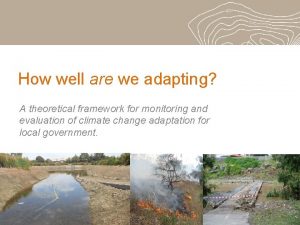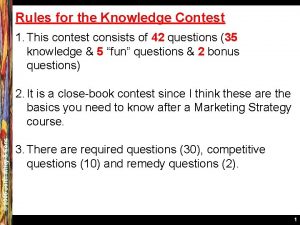Adapting Your Contest Strategies to the Rapidly Declining












- Slides: 12

Adapting Your Contest Strategies to the Rapidly Declining Solar Cycle 24 Two more years of declining solar activity Ø Then at least three years of solar minimum Ø Dayton 2016

Two More Years of Declining Solar Activity Then Three+ Years of Solar Minimum

What About Solar Cycle 25 ? ? Precursors of a possibly weak Solar Cycle 25 l Unusually weak solar polar magnetic field strengths l field strengths should reach their peak between 2018 and 2020 l Unusually large numbers of spotless days Sunspot Number l l l reported by the A-index Unusually late appearance of new Solar Cycle 25 sunspots l l possibly starting later this year or next year Unusually quiet geomagnetic field from 2018 to 2020+ l l www. solen. info/solar/polarfields. jpg new Solar Cycle 25 sun spots should appear by 2020 Unusually long solar minimum l solar flux in the low 70 s persisting after 2020 Accurate Cycle 25 forecasting is not possible until about three years after solar minimum 3

Declining Solar Activity Since Cycle 22 Suggests a Weak Solar Cycle 25? solarscience. msfc. nasa. gov/images/Cycle 22 Cycle 23 Cycle 24 big. gif

The Sun’s Polar Magnetic Field Strength Strong polar field strengths late in Solar Cycle 21 Weak polar field strengths late in Solar Cycle 23 Polar magnetic field strengths late in Cycle 24? -200 u. T Polar Field Strength +200 u. T A Reliable Precursor of Solar Cycle 25 www. solen. info/solar/polarfields/polar. html

160 Meter Propagation During the Two Year Decline to Solar Minimum l Improving DX propagation l stronger signals more reliable openings especially to Europe and Japan l lower geomagnetic activity l l l declining nighttime E layer absorption More crowded band conditions l l especially as we approach solar minimum in ~2020 declining daytime D layer absorption before sunset and after sunrise especially when there is no strong 40 meter propagation to Europe Longer and more regular worldwide openings l l reliable openings to Europe, Mid-East & north Africa 2130 -0830 Z more frequent openings to JA at our sunrise ~1200 -1230 Z

80 Meter Propagation During the Two Year Decline to Solar Minimum l Improving DX propagation l stronger signals more reliable openings especially to Europe and Japan l lower geomagnetic activity l l l declining nighttime E layer absorption More crowded band conditions l l especially as we approach solar minimum in ~2020 declining daytime D layer absorption before sunset and after sunrise especially when there is no strong 40 meter propagation to Europe Longer and more regular worldwide openings l l continuous openings to Europe, Mid-East & north Africa 2100 -0830 Z regular openings to JA starting before sunrise ~1130 -1300 Z

40 Meter Propagation During the Two Year Decline to Solar Minimum l l Nearly 24 hour DX propagation during CQWW CW Europe, Mid-East, north Africa propagation l l activity QSYs to 40 meters earlier in the afternoon ~1930 Z don’t miss the strong mid-afternoon European openings! § § l l strong openings often resume at European sunrise: ~0600 -0900 Z Japan, Far East and Central Asia propagation l l l brief direct path opening starting before JA sunset: 0800 -0900 Z weak skew path opening at ~ 240 degrees azimuth ~0900 -1130 Z the strongest opening from the east coast: ~1130 -1300 Z § l l l beginning at about 1930 Z to 2030 Z (earlier in New England) propagation may fail several hours after our sunset at about 0100 Z direct path strong signals for an hour or more strong long path signals at 150 degrees azimuth: VK/ZL and south Asia long path propagation south and central Asia long path propagation 2130 -2215 Z 2100 -2300 Z ~1200 -1300 Z

20 Meter Propagation During the Two Year Decline to Solar Minimum l Usually closes well before midnight l l usually stays closed all night Europe, Mid-East, north Africa propagation l from before our sunrise until mid afternoon § l l the opening may be delayed to until sunrise or later shorter openings than we’ve enjoyed in recent years afternoon short path opening from 2130 Z to about 0000 Z morning short path opening from about 1300 Z to about 1500 Z significantly shorter openings than we’ve enjoyed in recent years Long path to VK/ZL and south Asia starting in mid-afternoon l l ~1000 -1900 Z Japan, Far East and central Asia propagation l l ~0300 Z starting about 1900 Z until our sunset Long path to south Asia begins about an hour after our sunrise l starting about 1300 Z until about 1500 Z

15 Meter Propagation During the Two Year Decline to Solar Minimum l Usually closes a few hours after our sunset ~0200 Z l l Europe, Mid-East, north Africa propagation l l l always stays closed all night from about our sunrise until mid-afternoon 1200 Z to about 1800 Z much shorter openings than we’ve enjoyed in recent years Japan, Far East and central Asia propagation l l afternoon short path opening from 2130 to about 0000 Z morning long path opening from about 1300 Z to about 1400 Z polar opening to central Asia from about 1400 to about 1600 Z much shorter openings than we’ve enjoyed in recent years

10 Meter Propagation During the Two Year Decline to Solar Minimum l l Usually starts to open about an hour after our sunrise ~1300 Z Usually closes a few hours after our sunset ~0000 Z l l Europe, Mid-East, north Africa propagation l l l always stays closed all night short path propagation becomes less frequent and much shorter weak signal skew paths (110 -150 degrees) typically ~1400 -1700 Z Japan and Far East propagation l l l short path propagation is extremely unusual morning long path starting at about 1300 Z to about 1400 Z evening skew paths (200 -270 degrees) from ~2130 Z to 2230 Z

DX Contest Strategies for the Two Year Decline to Solar Minimum l l Improve your low band antennas this summer! Start the contest on 40 meters l l Capitalize on improving 160 and 80 M propagation 0200 -0830 Z l l l l the strong European opening could end after just a few hours mainly when 40 meters is not strongly open to Europe Look for a strong European opening on 40 meters 0600 -0900 Z 160, 80 and 40 meter openings to VK, ZL, JA 0900 -1230 Z Look for the start of the 20 M European opening 1000 -1200 Z Look for the start of the 15 M European opening 1200 -1400 Z Check 10 meters frequently for propagation 1300 -2200 Z Start of the strong 40 M meter European opening at ~2000 Z Look for short 15 and 20 meter JA openings 2130 -2300 Z
 Market hostility
Market hostility Strategies for mature and declining markets
Strategies for mature and declining markets 'adapting the message to your audience
'adapting the message to your audience Adapting to your audience
Adapting to your audience How well are we adapting
How well are we adapting Adapting marketing to the new economy
Adapting marketing to the new economy Adapting and adopting materials
Adapting and adopting materials Adapting to challenges of the micro environment
Adapting to challenges of the micro environment Adapting the price
Adapting the price The process of adapting borrowed cultural traits.
The process of adapting borrowed cultural traits. Adapting the price
Adapting the price How well are we adapting
How well are we adapting Adapting curriculum to bridge equity gaps
Adapting curriculum to bridge equity gaps






















